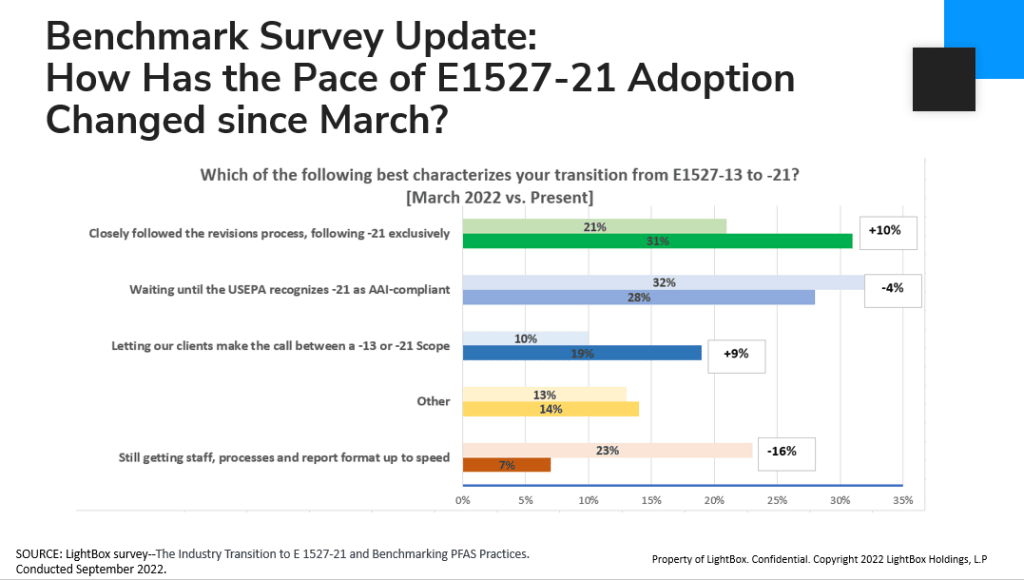It’s been nearly one year since ASTM published the revised version of the E 1527-21 Phase I ESA Standard Practice, and the industry transition is coming full circle. On Thursday, November 10th, LightBox hosted a webinar, Are We Done Yet?, which included a candid conversation about the impact of E1527-21 on Phase I ESA investigations and reporting with three leading ESA reviewers:
- Enrique Garcia, Executive Director, Environmental Risk Management, at JP Morgan Chase
- Lizz Lagomarsino, Principal at Lagomarsino Planning + Management
- Deborah Daniel, CEO and Founder of Environmental Professional Partners
Below are three key takeaways from our live event, followed by a link to the replay.
- The industry has partially adopted E1527-21, pending USEPA recognition as AAI-compliant.
In mid-September, LightBox conducted an industry benchmark survey of environmental consultants, which indicated that while 31% have transitioned over to the -21 version of ASTM’s E 1527 Phase I ESA standard—an increase from only 21% back in March. For another 28%, the U.S. EPA’s official recognition of the E1527-21 standard as compliant with AAI under CERCLA will be a major pivot point toward more widespread adoption (expected in December or January). From the reviewers on our panel, it’s clear that they are seeing more and more references to -21 as the year has marched on, but there is an industrywide hesitancy to fully adopt pending EPA’s Federal Register notice. [A live poll of the nearly 800 EPs on our webinar was very consistent with the September survey results.]
“Part of the issue is that so many consultants are doing it so many different ways right now. There’s no consistency because we’re in this interim period in advance of EPA adopting -21 under AAI.” Deborah Daniel
“There’s a lot of confusion. In bank work, we’re less concerned with meeting the letter of the standard than we are about determining the risk. ASTM is the guidance and framework for environmental due diligence, but if the Phase I doesn’t allow you to understand the risk, that’s where the problem comes in. That’s where there is still a disconnect. I’m not sure from the banks that -21 is the ‘end all be all’ for quality.” Lizz Lagomarsino
TAKEAWAY: The results emphasize the importance of EPs having conversations with their clients upfront on whether to follow -21 or -13 or a hybrid approach that is clearly defined at the onset of the Phase I project.

- 63% of EPs changed their report formats and added new terminology under E1527-21.
For the 31% of EPs who are following ASTM E1527-21 exclusively, many focused on making general formatting changes and adding new terminology to their Phase I ESA reports. Another common area of revision is conducting more research and including more documentation on historical research into adjoining properties under the new standard.
“We’re in the early stages of seeing information presented better. Some records are coming through well in -21 reports, but others are struggling with the presentation that E1527-21 is really looking for.” Deborah Daniel
“Mostly what I’m seeing is a lot more clarifying language and language that is specific to the changes that came with E1527-21. I’d like to see even more clarifying language, especially if the EP has decided that something didn’t interfere with the ability to come to a REC determination. I am also seeing more clarifying language with respect to adjoining properties and of course that was one of the bigger changes under -21.” Lizz Lagomarsino
TAKEAWAY: It’s an important time to review your Phase I ESA reports, considering the types of changes are other consultants are making as they transition to -21 to ensure that you’re not missing anything in advance of EPA recognizing -21 as AAI-compliant.
- 30% of EPs are addressing PFAS as a standard part of their Phase I ESAs.
In terms of the survey results regarding PFAS, it seems that the industry is adjusting to it being a real issue that needs to be dealt with. Nearly one-third (or 30%) of EPs are addressing it as a standard part of their Phase Is, but no consistency on what exactly is being done. The US EPA is going down the track of listing PFAS as a hazardous substance under CERCLA, but that could be years away. As an industry, conversations about PFAS are increasing, and there is a lot of confusion about when to consider PFAS, what sources to use, and how to use the data in assessing PFAS risk.
“At this point, there’s not enough information to address PFAS in a blanket approach like we see with a risk like asbestos, but if there’s a strong possibility that there’s a release that could be an issue, that’s where you need to have a conversation about how you’re going to address PFAS. It is being addressed, but not in every Phase I ESA report, nor do I think it needs to be. That’s for consultants to discuss with their clients.” Lizz Lagomarsino
TAKEAWAY: It’s important to ask questions about PFAS, stay abreast of developments, and educate your clients about the risk and how approaches are evolving in response to federal and state government activity.
FOR MORE INFORMATION
For a replay of our live event on November 10th, including more insights from this trio of reviewers on how -21-compliant reports look different, where EPs should be focused to avoid confusion, what reviewers see as the most common shortcomings in today’s Phase I reports, and advice to ensure you’re making a smooth transition to the -21 SOW. View here.
For our background resources on ASTM E1527 as well as links to past blogs and webinar replays, see our LightBox ASTM Resource Center.

